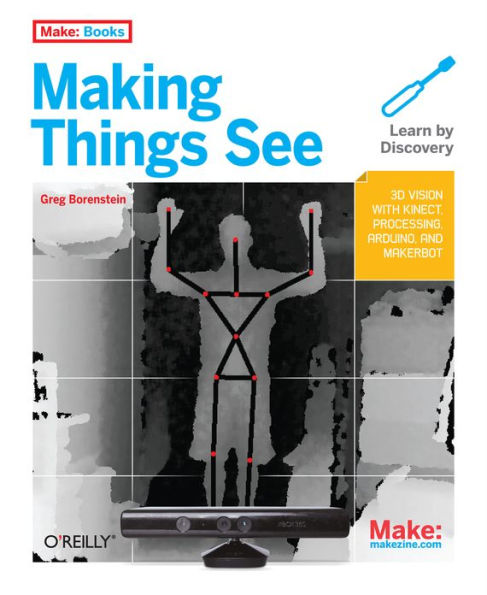This detailed, hands-on guide provides the technical and conceptual information you need to build cool applications with Microsoft’s Kinect, the amazing motion-sensing device that enables computers to see. Through half a dozen meaty projects, you’ll learn how to create gestural interfaces for software, use motion capture for easy 3D character animation, 3D scanning for custom fabrication, and many other applications.
Perfect for hobbyists, makers, artists, and gamers, Making Things See shows you how to build every project with inexpensive off-the-shelf components, including the open source Processing programming language and the Arduino microcontroller. You’ll learn basic skills that will enable you to pursue your own creative applications with Kinect.
- Create Kinect applications on Mac OS X, Windows, or Linux
- Track people with pose detection and skeletonization, and use blob tracking to detect objects
- Analyze and manipulate point clouds
- Make models for design and fabrication, using 3D scanning technology
- Use MakerBot, RepRap, or Shapeways to print 3D objects
- Delve into motion tracking for animation and games
- Build a simple robot arm that can imitate your arm movements
- Discover how skilled artists have used Kinect to build fascinating projects
This detailed, hands-on guide provides the technical and conceptual information you need to build cool applications with Microsoft’s Kinect, the amazing motion-sensing device that enables computers to see. Through half a dozen meaty projects, you’ll learn how to create gestural interfaces for software, use motion capture for easy 3D character animation, 3D scanning for custom fabrication, and many other applications.
Perfect for hobbyists, makers, artists, and gamers, Making Things See shows you how to build every project with inexpensive off-the-shelf components, including the open source Processing programming language and the Arduino microcontroller. You’ll learn basic skills that will enable you to pursue your own creative applications with Kinect.
- Create Kinect applications on Mac OS X, Windows, or Linux
- Track people with pose detection and skeletonization, and use blob tracking to detect objects
- Analyze and manipulate point clouds
- Make models for design and fabrication, using 3D scanning technology
- Use MakerBot, RepRap, or Shapeways to print 3D objects
- Delve into motion tracking for animation and games
- Build a simple robot arm that can imitate your arm movements
- Discover how skilled artists have used Kinect to build fascinating projects

Making Things See: 3D vision with Kinect, Processing, Arduino, and MakerBot
440
Making Things See: 3D vision with Kinect, Processing, Arduino, and MakerBot
440Related collections and offers

Product Details
| ISBN-13: | 9781449327781 |
|---|---|
| Publisher: | Make Community, LLC |
| Publication date: | 01/13/2012 |
| Sold by: | Barnes & Noble |
| Format: | eBook |
| Pages: | 440 |
| File size: | 13 MB |
| Note: | This product may take a few minutes to download. |
